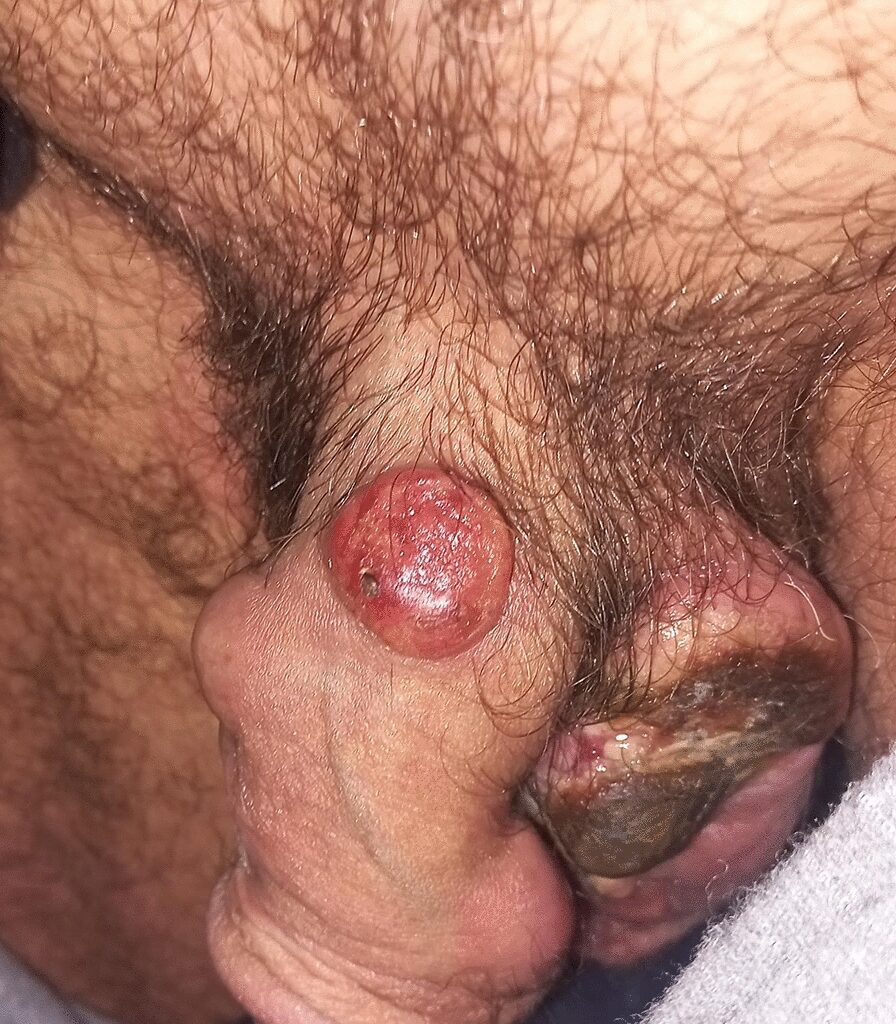Anaplastic large cell lymphoma (ALCL), a distinct form of non-Hodgkin lymphoma, was initially documented by Stein et al. in 1985 [10]. The World Health Organization’s 2016 classification system categorizes ALCL into four types on the basis of ALK expression: systemic ALK-positive ALCL (ALCL, ALK+), systemic ALK-negative ALCL (ALCL, ALK−), primary cutaneous ALCL (pcALCL), and breast implant-associated ALCL (BI-ALCL) [11,12,13]. Our case represents a rare manifestation of ALK-negative pcALCL.
Differential diagnosis of penile nodules
A key function of a case report is to educate clinicians on the diagnostic process for rare conditions, as the differential diagnosis for a penile mass is broad and requires careful evaluation to distinguish between malignant, benign, and infectious etiologies. Malignant possibilities include squamous cell carcinoma, the most common penile malignancy, which often presents as an ulcerative or fungating lesion [14,15,16], as well as other rare malignancies such as melanoma, Kaposi sarcoma, and metastatic disease from other primary sites [17,18,19]. Benign and inflammatory conditions must also be considered, such as Peyronie’s disease, which can present as a palpable, fibrous plaque, though it is typically associated with penile curvature [18] and inflammatory dermatoses such as lichen planus (violaceous plaques) and psoriasis (erythematous plaques) [19]. Finally, sexually transmitted infections are a critical differential; a primary syphilitic chancre typically presents as a painless ulcer, while condyloma acuminata (genital warts) appear as verrucous papules [19]. Definitive diagnosis in all cases of persistent penile lesions requires a biopsy with comprehensive histopathologic and immunohistochemical analysis.
Contextualization within literature: a comparative analysis
Primary penile lymphoma is exceptionally rare, and ALCL of the penis is rarer still. A review of literature reveals only a handful of cases, highlighting the importance of each report. To contextualize our findings, we present a comparative analysis of published cases.
Reference (author, year)
Patient age (years)
Clinical presentation
ALK status
Disease extent
Treatment administered
Outcome
Present case
60
Multiple penile nodules (largest 3 cm)
ALK-negative
Localized (pcALCL)
Brentuximab vedotin + CHOP (× 6 cycles)
Complete metabolic response; alive at follow-up
Luo et al., [14]
54
Recurrent penile ulcer; gastrointestinal symptoms
ALK-negative
Systemic (penis, colon, lymph nodes)
CHOP (× 1 cycle)
Died within 1 month (septic shock)
Li Chu et al. [15]
72
Two masses on the glans penis, initially presenting without B symptoms or lymphadenopathy
Not specified
Stage IE diffuse large B cell lymphoma of the glans penis
Resection; CHOP chemotherapy; interferon a-2b immunotherapy; rituximab (R)-CHOP chemotherapy; prednisolone and rituximab
Died due to treatment ineffectiveness on 22 February 2009. Developed brain metastases. Overall survival was 25 months
Fairfax et al. [20]
18
Painless penile ulcer for 7 months, gradually enlarged to 3 cm × 5 cm, occupying the entire dorsum and half the circumference. Also had daily fever (B symptoms)
Not reported
Stage IE (single extra lymphatic site) diffuse large cell immunoblastic lymphoma extending into the corpora cavernosa
8 courses of cyclophosphamide, doxorubicin, vincristine, and prednisone (CHOP)
Free of recurrence 27 months after diagnosis. Ulcer healed with scarring but with normal erectile function
This summary illustrates the heterogeneity in presentation, disease extent, and outcomes, reinforcing the lack of a standardized approach.
Therapeutic considerations and rationale for systemic chemotherapy
The choice of BV-CHOP for what was staged as localized pcALCL represents a significant deviation from standard practice and warrants a detailed justification. For solitary or localized lesions of pcALCL, the consensus first-line therapies are local modalities, such as surgical excision or radiation therapy [21,22,23,24,25,26,27,28]. These treatments are highly effective, achieving complete remission in approximately 95% of patients with localized disease [29].
Our decision to pursue aggressive systemic chemotherapy was made by a multidisciplinary team and was based on several high-risk features present in this case. The patient presented with multiple distinct nodules on the penis, with the largest lesion measuring 3 cm. This multifocal presentation, considered a higher-risk feature for which systemic therapy may be an appropriate consideration [30], combined with a large tumor burden, increased the risk of recurrence. Furthermore, the specific anatomical location and multifocality of the lesions made local control with surgery or radiation challenging. Surgical excision would have required significant penile resection, and radiation therapy would have carried a high risk of long-term morbidity, including fibrosis, urethral stricture, and erectile dysfunction. Given these factors, the decision was made to use a highly effective systemic regimen, BV-CHOP, typically reserved for systemic ALK-negative ALCL, with the goal of achieving a durable remission while preserving organ function [31].
Incorporating advanced prognostic and molecular insights
ALK status is a critical prognostic marker in ALCL, with ALK-negative disease generally having a poorer prognosis than ALK-positive disease [1]. ALK-negative ALCL results in a worse prognosis than ALK-positive ALCL, with 5-year survival rates of 50% and 70%, respectively [32]. However, the field is moving beyond this simple dichotomy. ALK-negative ALCL is not a monolithic entity. Gene expression profiling (GEP) studies have identified distinct molecular subgroups within ALK-negative ALCL and the broader category of peripheral T cell lymphomas (PTCL) [32]. For example, some studies have identified subgroups on the basis of the expression of transcription factors such as GATA3 and TBX21, which correlate with different clinical outcomes [33]. While such advanced molecular testing was not performed in this case, acknowledging its existence and potential value adds significant scientific depth and highlights a direction for future investigation.

